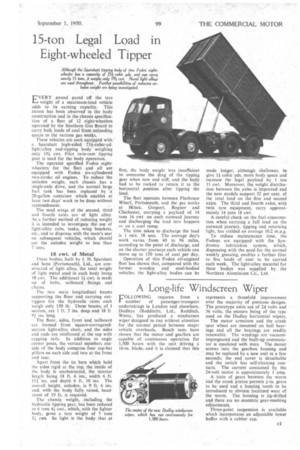15-ton Legal Load in Eight-wheeled Tipper
Page 37

If you've noticed an error in this article please click here to report it so we can fix it.
Although the Sparshatt tipping body of this Foden eight. wheeler has a capacity of 23i cubic yds. and can carry nearly 15 tons, it weighs only 191 cwt. Noral light alloys are useel throughout. Further possibilities of reducing un
laden weight are being investigated.
L" VERY pound pared off the tare LA weight of a maximum-load vehicle adds to its earning capacity. This axiom has been observed in the body construction and in the chassis specification of a fleet of 12 eight-wheelers operated by the Southern Gas Board to carry bulk loads of coal from unloading quays to the various gas works.
These vehicles are each equipped with a Sparshatt high-sided 23i-cubic-yd. light-alloy end-tipping body weighing only 19i cwt. Pilot twin-rain tipping gear is used for the body operation.
The operator specified Foden eightwheelers for the fleet and all are equipped with Foden six-cylindered two-stroke oil engines. To reduce the unladen weight, each chassis has a single-axle drive, and the normal large fuel tank has been replaced by a 20-gallon container which enables at least two days' work to be done without replenishment.
The mud wings of the second, third and fourth axles are of light alloy. As a further method of reducing weight it is intended to investigate the use of light-alloy cabs, tanks, wing brackets, etc., and to dispense with the mate's seat on subsequent vehicles, which should cut the unladen weight to less than 7 tons.
18 cwt of Metal
These bodies, built by J. H. Sparshatt and Sons (Portsmouth), Ltd., are constructed of light alloy, the total weight of light metal used in each body being 18 cwt. The additional 1 cwt, is made up of bolts, tailboard fixings and chains.
The two main longitudinal beams supporting the floor and carrying outriggers for the hydraulic rams each weigh only 150 lb. These beams, of 1 section, are 1 ft. 2 ins, deep and 18 ft 91 ins. long.
The floor, sides, front and tailboard are formed from square-corrugatedsection light-alloy sheet, and the sides and ends are reinforced at the top with capping rails. In addition to angle corner posts, the vertical members outside of the body comprise four top-hat pillars on each side and two at the front and rear.
Apart from the tie bars which hold the sides rigid at the top, the inside of the body is unobstructed, the interior length being 18 ft. 6 ins., width 6 ft. 111 ins, and depth 4 ft. 10 ins. The overall height, unladen, is 9 ft. 6 ins. and, with the body fully raised, headroom of 19 ft. is required.
The chassis weight, including the hydraulic tipping gear, has been reduced to 6 tons 41 cwt., which, with the lighter body, gives a tare weight of 7 tons 11 cwt. So light is the body that at first, the body weight was insufficient to overcome the drag of the tipping gear when new and stiff, and the body had to be rocked to return it to the horizontal position after tipping the load.
The fleet operates between Flathouse Wharf, Portsmouth, and the gas works at Hilsea, Gosport, Bognor arid Chichester, carrying a payload of 14 tons 16 cwt. on each outward journey and discharging the load into hoppers or on a coal ramp.
The time taken to discharge the load is 1 nsn. 18 secs. The average day's work varies from 40 to 96 miles, according to the point of discharge, and on the shorter journeys each vehicle can move up to 150 tons of coal per day.
Operation of this Foden oil-engined fleet has shown that, compared with the former wooden and steel-bodied vehicles, the light-alloy bodies can be made longer, although shallower, to give 11 cubic yds. more body space and increase the legal payload by 1 ton 11 cwt. Moreover, the weight distribution between the axles is improved and the new models support 32 per cent, of the total load on the first and second axles. The third and fourth axles, with twin tyre equipment, carry approximately 14 tons 18 cwt.
A careful check on the fuel consumption when carrying a full load on the outward journey, tipping and returning light, has yielded an average 10.2 m.p.g.
To reduce maintenance time, the Fodens arc equipped with the Syndrornic lubrication system, which, dispensing with the need for the normal weekly greasing, enables a further fdur to. five loads of coal to be carried each week. The light-alloy material for these bodies was supplied by the Northern Aluminium Co., Ltd.
















































































